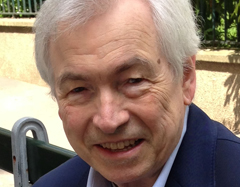2015 Monie A. Ferst Award
 Professor James R. Rice was born in Frederick, Maryland. He established himself as a genius in the field of applied mechanics from a very young age. He completed all three academic degrees — BS, MS, and PhD — in just six years, from 1958 to 1964. That pace was just a preview of a brilliant academic career that followed. He joined Brown University as a post-doctoral fellow in 1964 and then as a faculty member in 1965, becoming professor of engineering in 1970 and L. Herbert Ballou Professor of Theoretical and Applied Mechanics in 1973. Since 1981, he has been teaching at Harvard, first as the Gordon McKay Professor and then as the Mallinckrodt Professor of Engineering Sciences and Geophysics. Professor Rice was elected to all three major academies of the USA: American Academy of Arts and Sciences at the age of 37, National Academy of Engineering at the age of 39, and National Academy of Sciences at the age of 40. In addition, he holds many preeminent honors and recognitions, such as the foreign/corresponding memberships in the French Academy of Sciences, Royal Society of London, and Spanish Academy of Engineering; Fellow of ASME and American Geophysical Union; 7 honorary doctoral degrees from Lehigh University, Northwestern University, Brown University, Université Pierre et Marie Curie, Israel Institute of Technology at Technion, and Université Joseph Fourier; and top medals from several professional societies, such as the Timoshenko and Nadai Medals from ASME, the Prager Medal from SES, and Biot and the von Karman Medals from ASCE.
Professor James R. Rice was born in Frederick, Maryland. He established himself as a genius in the field of applied mechanics from a very young age. He completed all three academic degrees — BS, MS, and PhD — in just six years, from 1958 to 1964. That pace was just a preview of a brilliant academic career that followed. He joined Brown University as a post-doctoral fellow in 1964 and then as a faculty member in 1965, becoming professor of engineering in 1970 and L. Herbert Ballou Professor of Theoretical and Applied Mechanics in 1973. Since 1981, he has been teaching at Harvard, first as the Gordon McKay Professor and then as the Mallinckrodt Professor of Engineering Sciences and Geophysics. Professor Rice was elected to all three major academies of the USA: American Academy of Arts and Sciences at the age of 37, National Academy of Engineering at the age of 39, and National Academy of Sciences at the age of 40. In addition, he holds many preeminent honors and recognitions, such as the foreign/corresponding memberships in the French Academy of Sciences, Royal Society of London, and Spanish Academy of Engineering; Fellow of ASME and American Geophysical Union; 7 honorary doctoral degrees from Lehigh University, Northwestern University, Brown University, Université Pierre et Marie Curie, Israel Institute of Technology at Technion, and Université Joseph Fourier; and top medals from several professional societies, such as the Timoshenko and Nadai Medals from ASME, the Prager Medal from SES, and Biot and the von Karman Medals from ASCE.
Prof. Rice is regarded by many as the most influential scholar in the field of applied mechanics over the past fifty years. He identifies key issues at the heart of important problems in engineering and geophysical sciences, and then distills them into elegant, rigorous, and broadly applicable formulations that start new fields and allow for numerous developments by others. For example, his landmark single-author paper on the J-integral, published in Journal of Applied Mechanics in 1968, facilitated the creation of nonlinear fracture mechanics as a field of research for generations of young researchers. The long list of topics where Rice has defined or significantly advanced the research agenda includes: the J-integral and the HRR (Hutchinson-Rosengren-Rice) field; internal variable constitutive theories in plasticity; the ductile vs. brittle transition in solids; dislocation emission and intrinsic ductility from a crack tip; inelastic deformation of single crystals and polycrystals; interfacial fracture mechanics; the stability of plastic deformation and strain localization; poroelasticity and hydraulic fracturing; ductile fracture of metals; 3D weight function theory and crack front perturbations; mechanics of subduction zones; rate and state friction laws; continuum models of earthquake cycles; stability of frictional sliding and earthquake nucleation; spatio-temporal complexity of fault slip; dilatancy and compaction of fluid-infiltrated media; rupture propagation through geometrically complex fault networks; fault weakening due to shear heating; and combined thermo-poro-mechanical processes acting at the earthquake source. In each of these subject areas, Rice’s pioneering ideas serve as beacons of new directions of research for many other researchers. Recently, his interests have expanded to encompass tsunamis, glaciers, and landslides, with new work on the tsunami wave analysis, subglacial hydraulic fractures, episodic glacial motions, ice stream dynamics, and landslide instabilities.
Prof. Rice is not only a brilliant scholar, but also a great colleague, teacher, and mentor. As a colleague, he is modest and self-effacing. He has a mild demeanor, is very considerate of young people, and generous in sharing ideas with others. He is extremely talented at communicating complex mechanics ideas and analyses with insight and clarity to students from a broad range of backgrounds. He devotes a lot of time to class preparation and mentoring his graduate students and postdocs, as reflected in his Excellence in Mentoring Award from the Graduate Student Council at Harvard. Two of his graduate students have become members of the National Academy of Engineering. Most of his 60+ PhD students and postdocs have gone on to leading positions in teaching and/or research, including for example, full professorships at Brown, Caltech, Columbia, MIT, Northwestern, Stanford, UC Santa Barbara and University of Southern California.